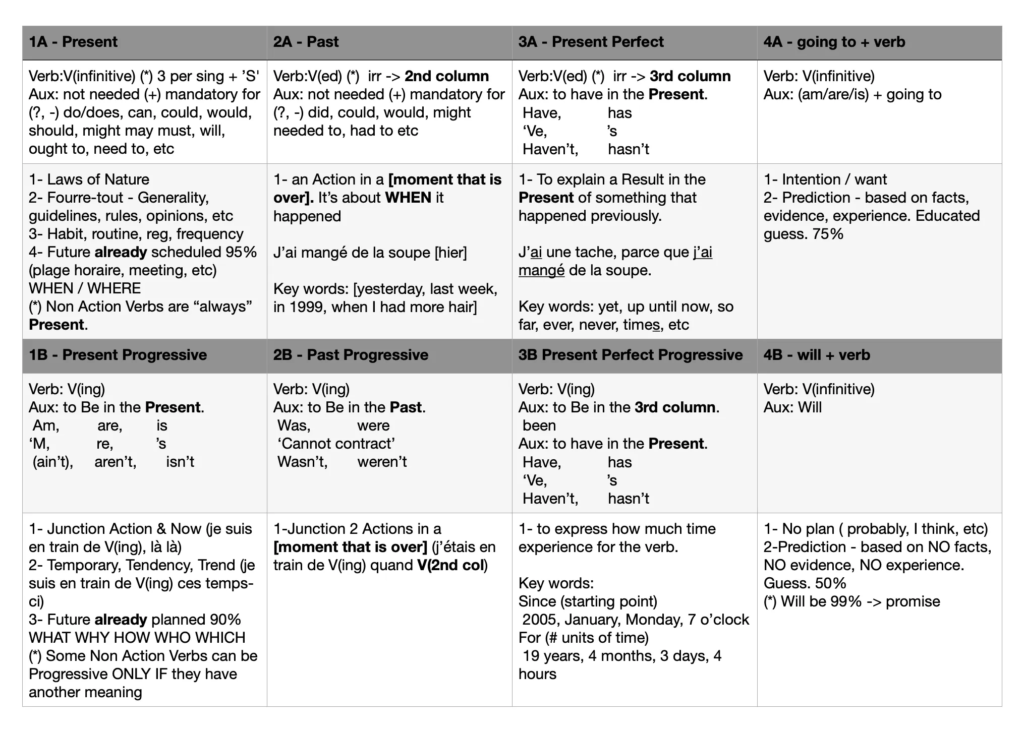Welcome to The Grid!

. . .
THE GRID: All the logic of English on a page!
You made it! You survived the Logic of English class… so far, so good!
The Grid summarizes English verb tenses and forms for ESL students, providing a concise overview of how to use various tenses in different SITUATIONS. After explaining each column in separate classes, we give our students “the Grid” as a comprehensive reminder of: all the logic of English on one page!
You’ll find the essential English logic tenses, all summarized on a single page. This Grid organizes key verb tenses making English easier to navigate and understand.
While there are more tenses in the language, they all follow similar principles. By adjusting the auxiliary verb to align with the appropriate time, you can easily adapt these structures for any context.
The Grid simplifies the complexities of English, helping you focus on the fundamentals and feel confident in your communication.
Let’s break down the content column by column:
. . .
1A - The Present (Simple)
– Verb: V+ (s)
– Auxiliaries not needed for (+) but mandatory for (?,-): Do/does, can could, would, should, may, might, must, will, shall, ought to, have to, need to, (am/is/are) able to, etc
– The Present (simple) is used for many different situations that have a permanent quality. Situations:
1) Laws of Nature (hey if you don’t like them, create your own universe!)
2) Generalities: permanent, opinions, rules, guidelines, settings, orders, directions, etc
3) Frequency: regular, habits, recurring, recurrent, etc

4) Future already scheduled: 95% WHEN / WHERE. For: appointment, meetings, vacations / holidays, reservations, tv programs / games, etc
(*) Non Action vers are “always” Present.
– – –

1B - The Present Progressive (continuous)
– Verb(ing)
– Auxiliary: to BE in the Present (am, are, is / CONTRACT: ‘m, ‘re, ‘s)
– The Present Progressive (continuous) is used for many different situations that have an ongoing quality:
1) Junction of an Action & (right) Now

2. Temporary, Tendency or Trend
(je suis en train de V(ing), ces temps-ci)

3. Future already planned (90% certainty) – WHAT, WHO, HOW, WHY, WHICH, HOW LONG, HOW FAR, etc
4. (*) Some non-action verbs can be Progressive ONLY IF that have a different meanings.
– – –

2A - The Past
– Verb + (ed); 93% of all verbs are regular / Irregular 2nd Column; 70% usage. See liste of Irregular Verbs.
– Auxiliaries not needed for (+) but mandatory for (?,-): Did, could, would, might, had to, needed to, (was/were) able to, etc
– Situation:
1. An action that happened in [a moment that is over], It’s about WHEN it happened
– Keywords: [yesterday, last week, in 1999, when I was in kindergarten], etc.
– – –

2B - The Past Progressive
– Verb(ing)
– Auxiliary: to BE in the Past (was, were / CANNOT CONTRACT)
– Situations:
1) Junction of 2 Actions in a [moment that is over].

3A - The Present Perfect
– Verb + (ed); 93% of all verbs are regular / Irregular 3rd Column; 70% usage. See liste of Irregular Verbs.
– Auxiliary: to HAVE in the Present (have, has / CONTRACT: ‘ve, ‘s)
– Situation:
1. To explain a Present situation / result of something that happened Previously.
– Keywords: so far = yet = up until now, ever, never, X times, etc.
– – –

3B - The Present Perfect Progressive
– Verb(ing)
– Auxiliary 2: to BE in the 3rd Column, CANNOT CONTRACT)
– Auxiliary 1: to HAVE in the Present (have, has / CONTRACT: ‘ve, ‘s)
– Situations:
1) To express how much time for the verb.
– Keywords: for (# units of time) i.e. 25 years, 11 months, 5 days, 7 hours, etc
Since (starting point) 1999, February, Monday, 7 o’clock.
– – –

4A - The Future Going To
We’re not gonna take it, No! (Twisted Sisters)
– Verb: V(infinitive)
– Auxiliary: (am/are/is) + going to
– Situation:
1. Expresses an intention;
2. Prediction based on facts, evidence or experience (75% certainty), “educated guess”
– – –

4B - The Future Will
– Verb(infinitive)
– Auxiliary : will, will not, CONTRACTION ‘ll, won’t
– Situation:
1. NO plan future, making a spontaneous decision as we speak
– Keywords: I think, probably, I’m sure… etc
2. Prediction based on NO facts, NO evidence, NO experience (50% certainty), “complete guess”
3. (*) Will be -> a promise (99% certainty)
– – –

All the logic in one page (not all the tenses)
This one-page overview, “the Grid,” is given after detailed instruction and practice, serving as a quick-reference guide that condenses 20-25 hours of teaching, depending on the level of the class. It highlights the different auxiliary verbs, verb forms, and key words or phrases that help understand the contexts in which each tense is used.
Additionally, there are more tenses beyond what is covered in the Grid. For example, the Conditional is not a tense per se but rather a way to structure a sentence, typically with an “if” clause on one side and “would” on the other.
There are also other “bonus” tenses that exist, but they follow the same logic as those already explained in the Grid. Since we have covered the Present and Past Progressive, there is no need at this point to add the Future Progressive as it follows the same pattern as the Present and the Past Progressive.
The same goes for Perfect tenses: if one understands that the Present Perfect follows a particular logic of a result in the Present, the Past and Future Perfect tenses apply that same logic by simply changing the auxiliary verb to reflect the appropriate time frame.